Andy Warhol
| Andy Warhol | |
|---|---|
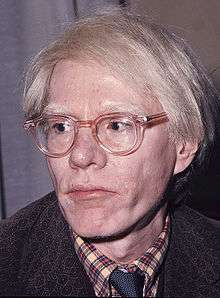 Warhol in 1975 | |
| Born |
Andrew Warhola August 6, 1928 Pittsburgh, Pennsylvania, U.S. |
| Died |
February 22, 1987 (aged 58) New York City, U.S. |
| Education | Carnegie Institute of Technology (Carnegie Mellon University) |
| Known for | Printmaking, painting, cinema, photography |
| Notable work |
Chelsea Girls (1966 film) Exploding Plastic Inevitable (1966 event) Campbell's Soup Cans (1962 painting) Marilyn Diptych (1962 painting) |
| Movement | Pop art |
Andy Warhol (/ˈwɔːrhɒl/;[1] born Andrew Warhola; August 6, 1928 – February 22, 1987) was an American artist, director and producer who was a leading figure in the visual art movement known as pop art. His works explore the relationship between artistic expression, celebrity culture, and advertising that flourished by the 1960s, and span a variety of media, including painting, silkscreening, photography, film, and sculpture. Some of his best known works include the silkscreen paintings Campbell's Soup Cans (1962) and Marilyn Diptych (1962), the experimental film Chelsea Girls (1966), and the multimedia events known as the Exploding Plastic Inevitable (1966–67).
Born and raised in Pittsburgh, Warhol initially pursued a successful career as a commercial illustrator. After exhibiting his work in several galleries in the late 1950s, he began to receive recognition as an influential and controversial artist. His New York studio, The Factory, became a well-known gathering place that brought together distinguished intellectuals, drag queens, playwrights, Bohemian street people, Hollywood celebrities, and wealthy patrons. He promoted a collection of personalities known as Warhol superstars, and is credited with coining the widely used expression "15 minutes of fame." In the late 1960s, he managed and produced the experimental rock band The Velvet Underground and founded Interview magazine. He authored numerous books, including The Philosophy of Andy Warhol and Popism: The Warhol Sixties. He lived openly as a gay man before the gay liberation movement. After gallbladder surgery, Warhol died of cardiac arrhythmia in February 1987 at the age of 58.
Warhol has been the subject of numerous retrospective exhibitions, books, and feature and documentary films. The Andy Warhol Museum in his native city of Pittsburgh, which holds an extensive permanent collection of art and archives, is the largest museum in the United States dedicated to a single artist. Many of his creations are very collectible and highly valuable. The highest price ever paid for a Warhol painting is US$105 million for a 1963 canvas titled Silver Car Crash (Double Disaster); his works include some of the most expensive paintings ever sold.[2] A 2009 article in The Economist described Warhol as the "bellwether of the art market".[3]
Biography
Early life and beginnings (1928–49)

Warhol was born on August 6, 1928, in Pittsburgh, Pennsylvania.[4] He was the fourth child of Ondrej Warhola (Americanized as Andrew Warhola, Sr., 1889–1942)[5][6][7] and Julia (née Zavacká, 1892–1972),[8] whose first child was born in their homeland and died before their move to the U.S.
His parents were working-class Lemko[9][10] emigrants from Mikó (now called Miková), located in today's northeastern Slovakia, part of the former Austro-Hungarian Empire. Warhol's father emigrated to the United States in 1914, and his mother joined him in 1921, after the death of Warhol's grandparents. Warhol's father worked in a coal mine. The family lived at 55 Beelen Street and later at 3252 Dawson Street in the Oakland neighborhood of Pittsburgh.[11] The family was Ruthenian Catholic and attended St. John Chrysostom Byzantine Catholic Church. Andy Warhol had two older brothers—Pavol (Paul), the oldest, was born before the family emigrated; Ján was born in Pittsburgh. Pavol's son, James Warhola, became a successful children's book illustrator.
In third grade, Warhol had Sydenham's chorea (also known as St. Vitus' Dance), the nervous system disease that causes involuntary movements of the extremities, which is believed to be a complication of scarlet fever which causes skin pigmentation blotchiness.[12] At times when he was confined to bed, he drew, listened to the radio and collected pictures of movie stars around his bed. Warhol later described this period as very important in the development of his personality, skill-set and preferences. When Warhol was 13, his father died in an accident.[13]
As a teenager, Warhol graduated from Schenley High School in 1945. Also as a teen, Warhol won a Scholastic Art and Writing Award.[14] After graduating from high school, his intentions were to study art education at the University of Pittsburgh in the hope of becoming an art teacher, but his plans changed and he enrolled in the Carnegie Institute of Technology, now Carnegie Mellon University in Pittsburgh, where he studied commercial art. During his time there, Warhol joined the campus Modern Dance Club and Beaux Arts Society.[15] He also served as art director of the student art magazine, Cano, illustrating a cover in 1948[16] and a full-page interior illustration in 1949.[17] These are believed to be his first two published artworks.[17] Warhol earned a Bachelor of Fine Arts in pictorial design in 1949.[18] Later that year, he moved to New York City and began a career in magazine illustration and advertising.
1950s
Warhol's early career was dedicated to commercial and advertising art, where his first commission had been to draw shoes for Glamour magazine in the late 1940s.[19] In the 1950s, Warhol worked as a designer for shoe manufacturer Israel Miller.[19][20] American photographer John Coplans recalled that
nobody drew shoes the way Andy did. He somehow gave each shoe a temperament of its own, a sort of sly, Toulouse-Lautrec kind of sophistication, but the shape and the style came through accurately and the buckle was always in the right place. The kids in the apartment [which Andy shared in New York – note by Coplans] noticed that the vamps on Andy's shoe drawings kept getting longer and longer but [Israel] Miller didn't mind. Miller loved them.
Warhol's "whimsical" ink drawings of shoe advertisements figured in some of his earliest showings at the Bodley Gallery in New York.
Warhol was an early adopter of the silk screen printmaking process as a technique for making paintings. A young Warhol was taught silk screen printmaking techniques by Max Arthur Cohn at his graphic arts business in Manhattan.[21] While working in the shoe industry, Warhol developed his "blotted line" technique, applying ink to paper and then blotting the ink while still wet, which was akin to a printmaking process on the most rudimentary scale. His use of tracing paper and ink allowed him to repeat the basic image and also to create endless variations on the theme, a method that prefigures his 1960s silk-screen canvas.[19] In his book Popism: The Warhol Sixties, Warhol writes: "When you do something exactly wrong, you always turn up something."[22][23]
Warhol habitually used the expedient of tracing photographs projected with an epidiascope.[24] Using prints by Edward Wallowitch, his 'first boyfriend'[25] the photographs would undergo a subtle transformation during Warhol's often cursory tracing of contours and hatching of shadows. Warhol used Wallowitch's photograph Young Man Smoking a Cigarette (c.1956),[26] for a 1958 design for a book cover he submitted to Simon and Schuster for the Walter Ross pulp novel The Immortal, and later used others for his dollar bill series,[27][28] and for Big Campbell's Soup Can with Can Opener (Vegetable), of 1962 which initiated Warhol's most sustained motif, the soup can.
With the rapid expansion of the record industry, RCA Records hired Warhol, along with another freelance artist, Sid Maurer, to design album covers and promotional materials.[29]
1960s
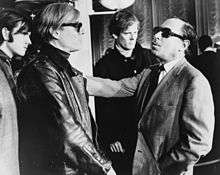
He began exhibiting his work during the 1950s. He held exhibitions at the Hugo Gallery[30] and the Bodley Gallery[31] in New York City; in California, his first West Coast gallery exhibition[32][33] was on July 9, 1962, in the Ferus Gallery of Los Angeles. The exhibition marked his West Coast debut of pop art.[34] Andy Warhol's first New York solo pop art exhibition was hosted at Eleanor Ward's Stable Gallery November 6–24, 1962. The exhibit included the works Marilyn Diptych, 100 Soup Cans, 100 Coke Bottles, and 100 Dollar Bills. At the Stable Gallery exhibit, the artist met for the first time poet John Giorno who would star in Warhol's first film, Sleep, in 1963.[35]
It was during the 1960s that Warhol began to make paintings of iconic American objects such as dollar bills, mushroom clouds, electric chairs, Campbell's Soup Cans, Coca-Cola bottles, celebrities such as Marilyn Monroe, Elvis Presley, Marlon Brando, Troy Donahue, Muhammad Ali, and Elizabeth Taylor, as well as newspaper headlines or photographs of police dogs attacking African-American protesters during the Birmingham campaign in the civil rights movement. During these years, he founded his studio, "The Factory" and gathered about him a wide range of artists, writers, musicians, and underground celebrities. His work became popular and controversial. Warhol had this to say about Coca-Cola:
What's great about this country is that America started the tradition where the richest consumers buy essentially the same things as the poorest. You can be watching TV and see Coca-Cola, and you know that the President drinks Coca-Cola, Liz Taylor drinks Coca-Cola, and just think, you can drink Coca-Cola, too. A Coke is a Coke and no amount of money can get you a better Coke than the one the bum on the corner is drinking. All the Cokes are the same and all the Cokes are good. Liz Taylor knows it, the President knows it, the bum knows it, and you know it.[36]
New York City's Museum of Modern Art hosted a Symposium on pop art in December 1962 during which artists such as Warhol were attacked for "capitulating" to consumerism. Critics were scandalized by Warhol's open embrace of market culture. This symposium set the tone for Warhol's reception.
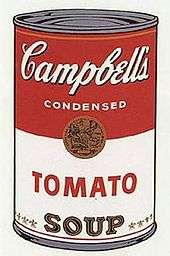
A pivotal event was the 1964 exhibit The American Supermarket, a show held in Paul Bianchini's Upper East Side gallery. The show was presented as a typical U.S. small supermarket environment, except that everything in it—from the produce, canned goods, meat, posters on the wall, etc.—was created by six prominent pop artists of the time, among them the controversial (and like-minded) Billy Apple, Mary Inman, and Robert Watts. Warhol's painting of a can of Campbell's soup cost $1,500 while each autographed can sold for $6. The exhibit was one of the first mass events that directly confronted the general public with both pop art and the perennial question of what art is.
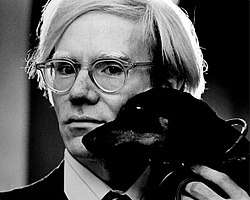
As an advertisement illustrator in the 1950s, Warhol used assistants to increase his productivity. Collaboration would remain a defining (and controversial) aspect of his working methods throughout his career; this was particularly true in the 1960s. One of the most important collaborators during this period was Gerard Malanga. Malanga assisted the artist with the production of silkscreens, films, sculpture, and other works at "The Factory", Warhol's aluminum foil-and-silver-paint-lined studio on 47th Street (later moved to Broadway). Other members of Warhol's Factory crowd included Freddie Herko, Ondine, Ronald Tavel, Mary Woronov, Billy Name, and Brigid Berlin (from whom he apparently got the idea to tape-record his phone conversations).[37]
During the 1960s, Warhol also groomed a retinue of bohemian and counterculture eccentrics upon whom he bestowed the designation "Superstars", including Nico, Joe Dallesandro, Edie Sedgwick, Viva, Ultra Violet, Holly Woodlawn, Jackie Curtis, and Candy Darling. These people all participated in the Factory films, and some—like Berlin—remained friends with Warhol until his death. Important figures in the New York underground art/cinema world, such as writer John Giorno and film-maker Jack Smith, also appear in Warhol films (many premiering at the New Andy Warhol Garrick Theatre and 55th Street Playhouse) of the 1960s, revealing Warhol's connections to a diverse range of artistic scenes during this time. Less well known was his support and collaboration with several teen-agers during this era, who would achieve prominence later in life including writer David Dalton,[38] photographer Stephen Shore[39] and artist Bibbe Hansen (mother of pop musician Beck).[40]
Attempted murder (1968)
On June 3, 1968, radical feminist writer Valerie Solanas shot Warhol and Mario Amaya, art critic and curator, at Warhol's studio.[41] Before the shooting, Solanas had been a marginal figure in the Factory scene. She authored in 1967 the S.C.U.M. Manifesto,[42] a separatist feminist tract that advocated the elimination of men; and appeared in the 1968 Warhol film I, a Man. Earlier on the day of the attack, Solanas had been turned away from the Factory after asking for the return of a script she had given to Warhol. The script had apparently been misplaced.[43]
Amaya received only minor injuries and was released from the hospital later the same day. Warhol was seriously wounded by the attack and barely survived: surgeons opened his chest and massaged his heart to help stimulate its movement again. He suffered physical effects for the rest of his life, including being required to wear a surgical corset.[12] The shooting had a profound effect on Warhol's life and art.[44][45]
Solanas was arrested the day after the assault, after turning herself in to police. By way of explanation, she said that Warhol "had too much control over my life." She was subsequently diagnosed with paranoid schizophrenia and eventually sentenced to three years under the control of the Department of Corrections. After the shooting, the Factory scene heavily increased security, and for many the "Factory 60s" ended.[45]
Warhol had this to say about the attack: "Before I was shot, I always thought that I was more half-there than all-there—I always suspected that I was watching TV instead of living life. People sometimes say that the way things happen in movies is unreal, but actually it's the way things happen in life that's unreal. The movies make emotions look so strong and real, whereas when things really do happen to you, it's like watching television—you don't feel anything. Right when I was being shot and ever since, I knew that I was watching television. The channels switch, but it's all television."[46]
1970s
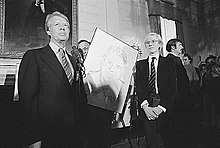
Compared to the success and scandal of Warhol's work in the 1960s, the 1970s were a much quieter decade, as he became more entrepreneurial. According to Bob Colacello, Warhol devoted much of his time to rounding up new, rich patrons for portrait commissions—including Shah of Iran Mohammad Reza Pahlavi, his wife Empress Farah Pahlavi, his sister Princess Ashraf Pahlavi, Mick Jagger, Liza Minnelli, John Lennon, Diana Ross, and Brigitte Bardot.[47][48] Warhol's famous portrait of Chinese Communist leader Mao Zedong was created in 1973. He also founded, with Gerard Malanga, Interview magazine, and published The Philosophy of Andy Warhol (1975). An idea expressed in the book: "Making money is art, and working is art and good business is the best art."[49]
Warhol socialized at various nightspots in New York City, including Max's Kansas City; and, later in the 1970s, Studio 54.[50] He was generally regarded as quiet, shy, and a meticulous observer. Art critic Robert Hughes called him "the white mole of Union Square."[51]
In 1979, along with his longtime friend Stuart Pivar, Warhol founded the New York Academy of Art.[52][53]
1980s
Warhol had a re-emergence of critical and financial success in the 1980s, partially due to his affiliation and friendships with a number of prolific younger artists, who were dominating the "bull market" of 1980s New York art: Jean-Michel Basquiat, Julian Schnabel, David Salle and other so-called Neo-Expressionists, as well as members of the Transavantgarde movement in Europe, including Francesco Clemente and Enzo Cucchi. Before the 1984 Sarajevo Winter Olympics, he teamed with 15 other artists, including David Hockney and Cy Twombly, and contributed a Speed Skater print to the Art and Sport collection. The Speed Skater was used for the official Sarajevo Winter Olympics poster.[54]
By this time, graffiti artist Fab Five Freddy paid homage to Warhol when he painted an entire train with Campbell soup cans. This was instrumental in Freddy becoming involved in the underground NYC art scene and becoming an affiliate of Basquiat.[55]
By this period, Warhol was being criticized for becoming merely a "business artist".[56] In 1979, reviewers disliked his exhibits of portraits of 1970s personalities and celebrities, calling them superficial, facile and commercial, with no depth or indication of the significance of the subjects. They also criticized his 1980 exhibit of 10 portraits at the Jewish Museum in Manhattan, entitled Jewish Geniuses, which Warhol—who was uninterested in Judaism and Jews—had described in his diary as "They're going to sell."[56] In hindsight, however, some critics have come to view Warhol's superficiality and commerciality as "the most brilliant mirror of our times," contending that "Warhol had captured something irresistible about the zeitgeist of American culture in the 1970s."[56]
Warhol also had an appreciation for intense Hollywood glamour. He once said: "I love Los Angeles. I love Hollywood. They're so beautiful. Everything's plastic, but I love plastic. I want to be plastic."[57]
In 1984, Warhol immortalized the singer Prince by creating one of his final portraits, Orange Prince (1984), a commission from Vanity Fair to accompany an article to celebrate the success of Prince's album and movie entitled Purple Rain.[58] Referencing the many celebrity portraits produced by Warhol across his career, Orange Prince (1984) was created using a similar composition to the Marilyn "Flavors" series from 1962, among some of Warhol's very first celebrity portraits.[59] Prince is depicted in a pop color palette commonly used by Warhol, in bright orange with highlights of bright green and blue. The facial features and hair are screen-printed in black over the orange background.[60][61][62]
In the Andy Warhol Diaries, Warhol recorded how excited he was to see Prince and Billy Idol together at a party in the mid 1980s, and he compared them to the Hollywood movie stars of the 1950s and '60s who also inspired his portraits: "... seeing these two glamour boys, its like boys are the new Hollywood glamour girls, like Jean Harlow and Marilyn Monroe".[63]
Works
Paintings
By the beginning of the 1960s, pop art was an experimental form that several artists were independently adopting; some of these pioneers, such as Roy Lichtenstein, would later become synonymous with the movement. Warhol, who would become famous as the "Pope of Pop", turned to this new style, where popular subjects could be part of the artist's palette. His early paintings show images taken from cartoons and advertisements, hand-painted with paint drips. Marilyn Monroe was a pop art painting that Warhol had done and it was very popular. Those drips emulated the style of successful abstract expressionists (such as Willem de Kooning). Warhol's first pop art paintings were displayed in April 1961, serving as the backdrop for New York Department Store Bronwit Teller's window display. This was the same stage his Pop Art contemporaries Jasper Johns, James Rosenquist and Robert Rauschenberg had also once graced.[64]
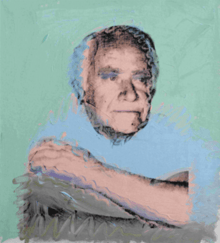
It was the gallerist Muriel Latow who came up with the ideas for both the soup cans and Warhol's dollar paintings. On November 23, 1961, Warhol wrote Latow a check for $50 which, according to the 2009 Warhol biography, Pop, The Genius of Warhol, was payment for coming up with the idea of the soup cans as subject matter.[65] For his first major exhibition, Warhol painted his famous cans of Campbell's soup, which he claimed to have had for lunch for most of his life. A 1964 Large Campbell's Soup Can was sold in a 2007 Sotheby's auction to a South American collector for £5.1 million ($7.4 million).[66]
He loved celebrities, so he painted them as well. From these beginnings he developed his later style and subjects. Instead of working on a signature subject matter, as he started out to do, he worked more and more on a signature style, slowly eliminating the handmade from the artistic process. Warhol frequently used silk-screening; his later drawings were traced from slide projections. At the height of his fame as a painter, Warhol had several assistants who produced his silk-screen multiples, following his directions to make different versions and variations.[67]
In 1979, Warhol was commissioned by BMW to paint a Group-4 race version of the then "elite supercar" BMW M1 for the fourth installment in the BMW Art Car Project. It was reported at the time that, unlike the three artists before him, Warhol opted to paint directly onto the automobile himself instead of letting technicians transfer his scale-model design to the car.[68] It was indicated that Warhol spent only a total of 23 minutes to paint the entire car.[69]
Warhol produced both comic and serious works; his subject could be a soup can or an electric chair. Warhol used the same techniques—silkscreens, reproduced serially, and often painted with bright colors—whether he painted celebrities, everyday objects, or images of suicide, car crashes, and disasters, as in the 1962–63 Death and Disaster series. The Death and Disaster paintings included Red Car Crash, Purple Jumping Man, and Orange Disaster. One of these paintings, the diptych Silver Car Crash, became the highest priced work of his when it sold at Sotheby's Contemporary Art Auction on Wednesday, November 13, 2013, for $105.4 million.[70]
Some of Warhol's work, as well as his own personality, has been described as being Keatonesque. Warhol has been described as playing dumb to the media. He sometimes refused to explain his work. He has suggested that all one needs to know about his work is "already there 'on the surface'."[71]
His Rorschach inkblots are intended as pop comments on art and what art could be. His cow wallpaper (literally, wallpaper with a cow motif) and his oxidation paintings (canvases prepared with copper paint that was then oxidized with urine) are also noteworthy in this context. Equally noteworthy is the way these works—and their means of production—mirrored the atmosphere at Andy's New York "Factory". Biographer Bob Colacello provides some details on Andy's "piss paintings":
Victor ... was Andy's ghost pisser on the Oxidations. He would come to the Factory to urinate on canvases that had already been primed with copper-based paint by Andy or Ronnie Cutrone, a second ghost pisser much appreciated by Andy, who said that the vitamin B that Ronnie took made a prettier color when the acid in the urine turned the copper green. Did Andy ever use his own urine? My diary shows that when he first began the series, in December 1977, he did, and there were many others: boys who'd come to lunch and drink too much wine, and find it funny or even flattering to be asked to help Andy 'paint'. Andy always had a little extra bounce in his walk as he led them to his studio.[72]
Warhol's first portrait of Basquiat (1982) is a black photo-silkscreen over an oxidized copper "piss painting".
After many years of silkscreen, oxidation, photography, etc., Warhol returned to painting with a brush in hand in a series of more than 50 large collaborative works done with Jean-Michel Basquiat between 1984 and 1986.[73][74] Despite negative criticism when these were first shown, Warhol called some of them "masterpieces," and they were influential for his later work.[75]
Andy Warhol was commissioned in 1984 by collector and gallerist Alexander Iolas to produce work based on Leonardo da Vinci's The Last Supper for an exhibition at the old refectory of the Palazzo delle Stelline in Milan, opposite from the Santa Maria delle Grazie where Leonardo da Vinci's mural can be seen.[76] Warhol exceeded the demands of the commission and produced nearly 100 variations on the theme, mostly silkscreens and paintings, and among them a collaborative sculpture with Basquiat, the Ten Punching Bags (Last Supper).[77] The Milan exhibition that opened in January 1987 with a set of 22 silk-screens, was the last exhibition for both the artist and the gallerist.[78] The series of The Last Supper was seen by some as "arguably his greatest,"[79] but by others as "wishy-washy, religiose" and "spiritless."[80] It is the largest series of religious-themed works by any U.S. artist.[79]
Artist Maurizio Cattelan describes that it is difficult to separate daily encounters from the art of Andy Warhol: "That's probably the greatest thing about Warhol: the way he penetrated and summarized our world, to the point that distinguishing between him and our everyday life is basically impossible, and in any case useless." Warhol was an inspiration towards Cattelan's magazine and photography compilations, such as Permanent Food, Charley, and Toilet Paper.[81]
In the period just before his death, Warhol was working on Cars, a series of paintings for Mercedes-Benz.[82]
A self-portrait by Andy Warhol (1963–64), which sold in New York at the May Post-War and Contemporary evening sale in Christie's, fetched $38.4 million.[83]
On May 9, 2012, his classic painting Double Elvis (Ferus Type) sold at auction at Sotheby's in New York for US$33 million. With commission, the sale price totaled US$37,042,500, short of the $50 million that Sotheby's had predicted the painting might bring. The piece (silkscreen ink and spray paint on canvas) shows Elvis Presley in a gunslinger pose. It was first exhibited in 1963 at the Ferus Gallery in Los Angeles. Warhol made 22 versions of the Double Elvis, nine of which are held in museums.[84]
In November 2013, his Silver Car Crash (Double Disaster) diptych sold at Sotheby's Contemporary Art Auction for $105.4 million, a new record for the pop artist (pre-auction estimates were at $80 million).[70] Created in 1963, this work had rarely been seen in public in the previous years.[85] In November 2014, Triple Elvis sold for $81.9m (£51.9m) at an auction in New York.[86]
Films
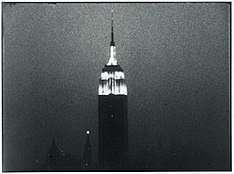
Warhol worked across a wide range of media—painting, photography, drawing, and sculpture. In addition, he was a highly prolific filmmaker. Between 1963 and 1968, he made more than 60 films,[87] plus some 500 short black-and-white "screen test" portraits of Factory visitors.[88] One of his most famous films, Sleep, monitors poet John Giorno sleeping for six hours. The 35-minute film Blow Job is one continuous shot of the face of DeVeren Bookwalter supposedly receiving oral sex from filmmaker Willard Maas, although the camera never tilts down to see this. Another, Empire (1964), consists of eight hours of footage of the Empire State Building in New York City at dusk. The film Eat consists of a man eating a mushroom for 45 minutes. Warhol attended the 1962 premiere of the static composition by LaMonte Young called Trio for Strings and subsequently created his famous series of static films including Kiss, Eat, and Sleep (for which Young initially was commissioned to provide music). Uwe Husslein cites filmmaker Jonas Mekas, who accompanied Warhol to the Trio premiere, and who claims Warhol's static films were directly inspired by the performance.[89]
Batman Dracula is a 1964 film that was produced and directed by Warhol, without the permission of DC Comics. It was screened only at his art exhibits. A fan of the Batman series, Warhol's movie was an "homage" to the series, and is considered the first appearance of a blatantly campy Batman. The film was until recently thought to have been lost, until scenes from the picture were shown at some length in the 2006 documentary Jack Smith and the Destruction of Atlantis.
Warhol's 1965 film Vinyl is an adaptation of Anthony Burgess' popular dystopian novel A Clockwork Orange. Others record improvised encounters between Factory regulars such as Brigid Berlin, Viva, Edie Sedgwick, Candy Darling, Holly Woodlawn, Ondine, Nico, and Jackie Curtis. Legendary underground artist Jack Smith appears in the film Camp.
His most popular and critically successful film was Chelsea Girls (1966). The film was highly innovative in that it consisted of two 16 mm-films being projected simultaneously, with two different stories being shown in tandem. From the projection booth, the sound would be raised for one film to elucidate that "story" while it was lowered for the other. The multiplication of images evoked Warhol's seminal silk-screen works of the early 1960s.
Warhol was a fan of filmmaker Radley Metzger's film work[90] and commented that Metzger's film, The Lickerish Quartet, was "an outrageously kinky masterpiece".[91][92][93] Blue Movie—a film in which Warhol superstar Viva makes love in bed with Louis Waldon, another Warhol superstar—was Warhol's last film as director.[94][95] The film, a seminal film in the Golden Age of Porn, was, at the time, controversial for its frank approach to a sexual encounter.[96][97] Blue Movie was publicly screened in New York City in 2005, for the first time in more than 30 years.[98]
After his June 3, 1968, shooting, a reclusive Warhol relinquished his personal involvement in filmmaking. His acolyte and assistant director, Paul Morrissey, took over the film-making chores for the Factory collective, steering Warhol-branded cinema towards more mainstream, narrative-based, B-movie exploitation fare with Flesh, Trash, and Heat. All of these films, including the later Andy Warhol's Dracula and Andy Warhol's Frankenstein, were far more mainstream than anything Warhol as a director had attempted. These latter "Warhol" films starred Joe Dallesandro—more of a Morrissey star than a true Warhol superstar.
In the early 1970s, most of the films directed by Warhol were pulled out of circulation by Warhol and the people around him who ran his business. After Warhol's death, the films were slowly restored by the Whitney Museum and are occasionally projected at museums and film festivals. Few of the Warhol-directed films are available on video or DVD.
Filmography
Factory in New York
- Factory: 1342 Lexington Avenue (the first Factory)
- The Factory: 231 East 47th Street, 1963–67 (the building no longer exists)
- Factory: 33 Union Square, 1967–73 (Decker Building)
- Factory: 860 Broadway (near 33 Union Square), 1973–84 (the building has now been completely remodeled and was for a time (2000–2001) the headquarters of the dot-com consultancy Scient)
- Factory: 22 East 33rd Street, 1984–87 (the building no longer exists)
- Home: 1342 Lexington Avenue
- Home: 57 East 66th Street (Warhol's last home)
- Last personal studio: 158 Madison Avenue
Music
In the mid-1960s, Warhol adopted the band the Velvet Underground, making them a crucial element of the Exploding Plastic Inevitable multimedia performance art show. Warhol, with Paul Morrissey, acted as the band's manager, introducing them to Nico (who would perform with the band at Warhol's request). In 1966 he "produced" their first album The Velvet Underground & Nico, as well as providing its album art. His actual participation in the album's production amounted to simply paying for the studio time. After the band's first album, Warhol and band leader Lou Reed started to disagree more about the direction the band should take, and their artistic friendship ended. In 1989, after Warhol's death, Reed and John Cale re-united for the first time since 1972 to write, perform, record and release the concept album Songs for Drella, a tribute to Warhol.
Warhol designed many album covers for various artists starting with the photographic cover of John Wallowitch's debut album, This Is John Wallowitch!!! (1964). He designed the cover art for The Rolling Stones' albums Sticky Fingers (1971) and Love You Live (1977), and the John Cale albums The Academy in Peril (1972) and Honi Soit in 1981. One of Warhol's last works was a portrait of Aretha Franklin for the cover of her 1986 gold album Aretha, which was done in the style of the Reigning Queens series he had completed the year before.[99]
Warhol strongly influenced the new wave/punk rock band Devo, as well as David Bowie. Bowie recorded a song called "Andy Warhol" for his 1971 album Hunky Dory. Lou Reed wrote the song "Andy's Chest", about Valerie Solanas, the woman who shot Warhol, in 1968. He recorded it with the Velvet Underground, and this version was released on the VU album in 1985. Bowie would later play Warhol in the 1996 movie, Basquiat. Bowie recalled how meeting Warhol in real life helped him in the role, and recounted his early meetings with him:
I met him a couple of times, but we seldom shared more than platitudes. The first time we saw each other an awkward silence fell till he remarked my bright yellow shoes and started talking enthusiastically. He wanted to be very superficial. And seemingly emotionless, indifferent, just like a dead fish. Lou Reed described him most profoundly when he once told me they should bring a doll of Andy on the market: a doll that you wind up and doesn't do anything. But I managed to observe him well, and that was a helping hand for the film [Basquiat]. … We borrowed his clothes from the museum in Pittsburgh, and they were intact, unwashed. Even the pockets weren't emptied: they contained pancake, white, deadly pale fond de teint which Andy always smeared on his face, a check torn in pieces, someone's address, lots of homeopathic pills and a wig. Andy always wore those silver wigs, but he never admitted it were wigs. One of his hairdressers has told me lately that he had his wigs regularly cut, like it were real hair. When the wig was trimmed, he put on another next month as if his hair had grown.[100]
Books and print

Beginning in the early 1950s, Warhol produced several unbound portfolios of his work.
The first of several bound self-published books by Warhol was 25 Cats Name Sam and One Blue Pussy, printed in 1954 by Seymour Berlin on Arches brand watermarked paper using his blotted line technique for the lithographs. The original edition was limited to 190 numbered, hand colored copies, using Dr. Martin's ink washes. Most of these were given by Warhol as gifts to clients and friends. Copy No. 4, inscribed "Jerry" on the front cover and given to Geraldine Stutz, was used for a facsimile printing in 1987,[101] and the original was auctioned in May 2006 for US $35,000 by Doyle New York.[102]
Other self-published books by Warhol include:
- A Gold Book
- Wild Raspberries
- Holy Cats
Warhol's book A La Recherche du Shoe Perdu (1955) marked his "transition from commercial to gallery artist".[103] (The title is a play on words by Warhol on the title of French author Marcel Proust's À la recherche du temps perdu.)[103]
After gaining fame, Warhol "wrote" several books that were commercially published:
- a, A Novel (1968, ISBN 0-8021-3553-6) is a literal transcription—containing spelling errors and phonetically written background noise and mumbling—of audio recordings of Ondine and several of Andy Warhol's friends hanging out at the Factory, talking, going out.
- The Philosophy of Andy Warhol (From A to B & Back Again) (1975, ISBN 0-15-671720-4)—according to Pat Hackett's introduction to The Andy Warhol Diaries, Pat Hackett did the transcriptions and text for the book based on daily phone conversations, sometimes (when Warhol was traveling) using audio cassettes that Andy Warhol gave her. Said cassettes contained conversations with Brigid Berlin (also known as Brigid Polk) and former Interview magazine editor Bob Colacello.
- Popism: The Warhol Sixties (1980, ISBN 0-15-672960-1), authored by Warhol and Pat Hackett, is a retrospective view of the 1960s and the role of pop art.
- The Andy Warhol Diaries (1989, ISBN 0-446-39138-7), edited by Pat Hackett, is a diary dictated by Warhol to Hackett in daily phone conversations. Warhol started the diary to keep track of his expenses after being audited, although it soon evolved to include his personal and cultural observations.[104]
Warhol created the fashion magazine Interview that is still published today. The loopy title script on the cover is thought to be either his own handwriting or that of his mother, Julia Warhola, who would often do text work for his early commercial pieces.[105]
Other media
Although Andy Warhol is most known for his paintings and films, he authored works in many different media.
- Drawing: Warhol started his career as a commercial illustrator, producing drawings in "blotted-ink" style for advertisements and magazine articles. Best known of these early works are his drawings of shoes. Some of his personal drawings were self-published in small booklets, such as Yum, Yum, Yum (about food), Ho, Ho, Ho (about Christmas) and Shoes, Shoes, Shoes. His most artistically acclaimed book of drawings is probably A Gold Book, compiled of sensitive drawings of young men. A Gold Book is so named because of the gold leaf that decorates its pages.[106] In April 2012 a sketch of 1930s singer Rudy Vallee claimed to have been drawn by Andy Warhol was found at a Las Vegas garage sale. The image was said to have been drawn when Andy was nine or 10.[107] Various authorities have challenged the image's authenticity.
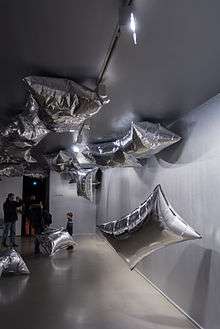 Silver Clouds Reproduction at the Musée d'Art Moderne de la Ville de Paris, December 2015, Warhol Unlimited Exposition
Silver Clouds Reproduction at the Musée d'Art Moderne de la Ville de Paris, December 2015, Warhol Unlimited Exposition - Sculpture: Warhol's most famous sculpture is probably his Brillo Boxes, silkscreened ink on wood replicas of the large, branded cardboard boxes used to hold 24 packages of Brillo soap pads. The original Brillo design was by commercial artist James Harvey. Warhol's sculpture was part of a series of "grocery carton" works that also included Heinz ketchup and Campbell's tomato juice cases.[108] Other famous works include the Silver Clouds—helium filled, silver mylar, pillow-shaped balloons. A Silver Cloud was included in the traveling exhibition Air Art (1968–1969) curated by Willoughby Sharp. Clouds was also adapted by Warhol for avant-garde choreographer Merce Cunningham's dance piece RainForest (1968).[109]
- Audio: At one point Warhol carried a portable recorder with him wherever he went, taping everything everybody said and did. He referred to this device as his "wife". Some of these tapes were the basis for his literary work. Another audio-work of Warhol's was his Invisible Sculpture, a presentation in which burglar alarms would go off when entering the room. Warhol's cooperation with the musicians of The Velvet Underground was driven by an expressed desire to become a music producer.
- Time Capsules: In 1973, Warhol began saving ephemera from his daily life—correspondence, newspapers, souvenirs, childhood objects, even used plane tickets and food—which was sealed in plain cardboard boxes dubbed Time Capsules. By the time of his death, the collection grew to include 600, individually dated "capsules". The boxes are now housed at the Andy Warhol Museum.[110]
- Television: Andy Warhol dreamed of a television special about a favorite subject of his – Nothing – that he would call The Nothing Special. Later in his career he did create two cable television shows, Andy Warhol's TV in 1982 and Andy Warhol's Fifteen Minutes (based on his famous "fifteen minutes of fame" quotation) for MTV in 1986. Besides his own shows he regularly made guest appearances on other programs, including The Love Boat wherein a Midwestern wife (Marion Ross) fears Andy Warhol will reveal to her husband (Tom Bosley, who starred alongside Ross in sitcom Happy Days) her secret past as a Warhol superstar named Marina del Rey. Warhol also produced a TV commercial for Schrafft's Restaurants in New York City, for an ice cream dessert appropriately titled the "Underground Sundae".[111]
- Fashion: Warhol is quoted for having said: "I'd rather buy a dress and put it up on the wall, than put a painting, wouldn't you?"[112] One of his most well-known Superstars, Edie Sedgwick, aspired to be a fashion designer, and his good friend Halston was a famous one. Warhol's work in fashion includes silkscreened dresses, a short sub-career as a catwalk-model and books on fashion as well as paintings with fashion (shoes) as a subject. Warhol himself has been described as a modern dandy, whose authority "rested more on presence than on words".[113]
- Performance Art: Warhol and his friends staged theatrical multimedia happenings at parties and public venues, combining music, film, slide projections and even Gerard Malanga in an S&M outfit cracking a whip. The Exploding Plastic Inevitable in 1966 was the culmination of this area of his work.[114]
- Theater: Andy Warhol's Pork opened on May 5, 1971, at LaMama theater in New York for a two-week run and was brought to the Roundhouse in London for a longer run in August 1971. Pork was based on tape-recorded conversations between Brigid Berlin and Andy during which Brigid would play for Andy tapes she had made of phone conversations between herself and her mother, socialite Honey Berlin. The play featured Jayne County as "Vulva" and Cherry Vanilla as "Amanda Pork".[115] In 1974, Andy Warhol also produced the stage musical Man on the Moon, which was written by John Phillips of the Mamas and the Papas.
- Photography: To produce his silkscreens, Warhol made photographs or had them made by his friends and assistants. These pictures were mostly taken with a specific model of Polaroid camera that Polaroid kept in production especially for Warhol. This photographic approach to painting and his snapshot method of taking pictures has had a great effect on artistic photography. Warhol was an accomplished photographer, and took an enormous amount of photographs of Factory visitors, friends.
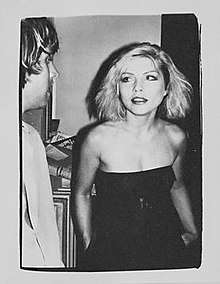 Photograph of Debbie Harry by Andy Warhol, taken in 1980 in the Factory on the day of the photo-shoot for her silkscreen portraits
Photograph of Debbie Harry by Andy Warhol, taken in 1980 in the Factory on the day of the photo-shoot for her silkscreen portraits - Computer: Warhol used Amiga computers to generate digital art, including You Are the One, which he helped design and build with Amiga, Inc. He also displayed the difference between slow fill and fast fill on live TV with Debbie Harry as a model.[116] (video)
Producer and product
He founded the gossip magazine Interview, a stage for celebrities he "endorsed" and a business staffed by his friends. He collaborated with others on all of his books (some of which were written with Pat Hackett.) He adopted the young painter Jean-Michel Basquiat, and the band The Velvet Underground, presenting them to the public as his latest interest, and collaborating with them. One might even say that he produced people (as in the Warholian "Superstar" and the Warholian portrait). He endorsed products, appeared in commercials, and made frequent celebrity guest appearances on television shows and in films (he appeared in everything from Love Boat[117] to Saturday Night Live[118] and the Richard Pryor movie Dynamite Chicken[119]).
In this respect Warhol was a fan of "Art Business" and "Business Art"—he, in fact, wrote about his interest in thinking about art as business in The Philosophy of Andy Warhol from A to B and Back Again.[120]
Personal life
Sexuality
Warhol was gay.[121][122] Interviewed in 1980, he indicated that he was still a virgin—biographer Bob Colacello who was present at the interview felt it was probably true and that what little sex he had was probably "a mixture of voyeurism and masturbation—to use [Andy's] word abstract".[123] Warhol's assertion of virginity would seem to be contradicted by his hospital treatment in 1960 for condylomata, a sexually transmitted disease.[124] It has also been contradicted by his lovers, including Warhol muse BillyBoy who has said they had sex to orgasm: "When he wasn't being Andy Warhol and when you were just alone with him he was an incredibly generous and very kind person. What seduced me was the Andy Warhol who I saw alone. In fact when I was with him in public he kind of got on my nerves….I'd say: 'You're just obnoxious, I can't bear you."[125] Asked if Warhol was only a voyeur, Billy Name also denied it, saying: "He was the essence of sexuality. It permeated everything. Andy exuded it, along with his great artistic creativity….It brought a joy to the whole art world in New York."[126] "But his personality was so vulnerable that it became a defense to put up the blank front."[127] Warhol's lovers included John Giorno,[128] Billy Name,[129] Charles Lisanby,[130] and Jon Gould. His boyfriend of 12 years was Jed Johnson, whom he met in 1968, and who later achieved fame as an interior designer.[131]
The fact that Warhol's homosexuality influenced his work and shaped his relationship to the art world is a major subject of scholarship on the artist and is an issue that Warhol himself addressed in interviews, in conversation with his contemporaries, and in his publications (e.g., Popism: The Warhol 1960s). Throughout his career, Warhol produced erotic photography and drawings of male nudes. Many of his most famous works (portraits of Liza Minnelli, Judy Garland, and Elizabeth Taylor, and films such as Blow Job, My Hustler and Lonesome Cowboys) draw from gay underground culture or openly explore the complexity of sexuality and desire. As has been addressed by a range of scholars, many of his films premiered in gay porn theaters, including the New Andy Warhol Garrick Theatre and 55th Street Playhouse, in the late 1960s.[132]
The first works that Warhol submitted to a fine art gallery, homoerotic drawings of male nudes, were rejected for being too openly gay.'[25] In Popism, furthermore, the artist recalls a conversation with the film maker Emile de Antonio about the difficulty Warhol had being accepted socially by the then-more-famous (but closeted) gay artists Jasper Johns and Robert Rauschenberg. De Antonio explained that Warhol was "too swish and that upsets them." In response to this, Warhol writes, "There was nothing I could say to that. It was all too true. So I decided I just wasn't going to care, because those were all the things that I didn't want to change anyway, that I didn't think I 'should' want to change ... Other people could change their attitudes but not me".[25][133] In exploring Warhol's biography, many turn to this period—the late 1950s and early 1960s—as a key moment in the development of his persona. Some have suggested that his frequent refusal to comment on his work, to speak about himself (confining himself in interviews to responses like "Um, no" and "Um, yes", and often allowing others to speak for him)—and even the evolution of his pop style—can be traced to the years when Warhol was first dismissed by the inner circles of the New York art world.[134]
Religious beliefs
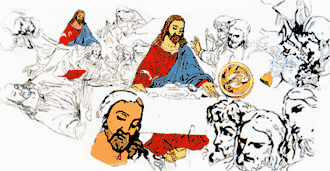
Warhol was a practicing Ruthenian Catholic. He regularly volunteered at homeless shelters in New York City, particularly during the busier times of the year, and described himself as a religious person.[136] Many of Warhol's later works depicted religious subjects, including two series, Details of Renaissance Paintings (1984) and The Last Supper (1986). In addition, a body of religious-themed works was found posthumously in his estate.[136]
During his life, Warhol regularly attended Mass, and the priest at Warhol's church, Saint Vincent Ferrer, said that the artist went there almost daily,[136] although he was not observed taking Communion or going to Confession and sat or knelt in the pews at the back.[123] The priest thought he was afraid of being recognized; Warhol said he was self-conscious about being seen in a Roman Rite church crossing himself "in the Orthodox way" (right to left instead of the reverse).[123]
His art is noticeably influenced by the Eastern Christian tradition which was so evident in his places of worship.[136]
Warhol's brother has described the artist as "really religious, but he didn't want people to know about that because [it was] private". Despite the private nature of his faith, in Warhol's eulogy John Richardson depicted it as devout: "To my certain knowledge, he was responsible for at least one conversion. He took considerable pride in financing his nephew's studies for the priesthood".[136]
Collections
Warhol was an avid collector. His friends referred to his numerous collections, which filled not only his four-story townhouse, but also a nearby storage unit, as "Andy's Stuff." The true extent of his collections was not discovered until after his death, when the Andy Warhol Museum in Pittsburgh took in 641 boxes of his "Stuff."
Warhol's collections included a Coca-cola memorabilia sign, and 19th century paintings[137] along with airplane menus, unpaid invoices, pizza dough, pornographic pulp novels, newspapers, stamps, supermarket flyers, and cookie jars, among other eccentricities. It also included significant works of art, such as George Bellows's Miss Bentham.[138] One of his main collections was his wigs. Warhol owned more than 40 and felt very protective of his hairpieces, which were sewn by a New York wig-maker from hair imported from Italy. In 1985 a girl snatched Warhol's wig off his head. It was later discovered in Warhol's diary entry for that day that he wrote: "I don't know what held me back from pushing her over the balcony."
Another item found in Warhol's boxes at the museum in Pittsburgh was a mummified human foot from Ancient Egypt. The curator of anthropology at Carnegie Museum of Natural History felt that Warhol most likely found it at a flea market.[139]
Death
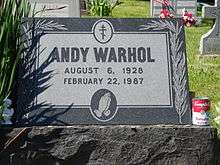
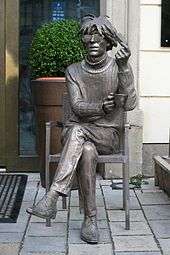
Warhol died in Manhattan at 6:32 a.m. on February 22, 1987 at age 58. According to news reports, he had been making a good recovery from gallbladder surgery at New York Hospital before dying in his sleep from a sudden post-operative irregular heartbeat.[140] Prior to his diagnosis and operation, Warhol delayed having his recurring gallbladder problems checked, as he was afraid to enter hospitals and see doctors.[52] His family sued the hospital for inadequate care, saying that the arrhythmia was caused by improper care and water intoxication.[141] The malpractice case was quickly settled out of court; Warhol's family received an undisclosed sum of money.[142]
Shortly before Warhol's death, doctors expected Warhol to survive the surgery, though a revaluation of the case about thirty years after his death showed many indications that Warhol's surgery was in fact riskier than originally thought.[143] It was widely reported at the time that Warhol died of a "routine" surgery, though when considering factors such as his age, a family history of gallbladder problems, his previous gunshot wounds, and his medical state in the weeks leading up to the procedure, the potential risk of death following the surgery appeared to have been significant.[143]
Warhol's brothers took his body back to Pittsburgh, where an open-coffin wake was held at the Thomas P. Kunsak Funeral Home. The solid bronze casket had gold-plated rails and white upholstery. Warhol was dressed in a black cashmere suit, a paisley tie, a platinum wig, and sunglasses. He was laid out holding a small prayer book and a red rose. The funeral liturgy was held at the Holy Ghost Byzantine Catholic Church on Pittsburgh's North Side. The eulogy was given by Monsignor Peter Tay. Yoko Ono and John Richardson were speakers. The coffin was covered with white roses and asparagus ferns. After the liturgy, the coffin was driven to St. John the Baptist Byzantine Catholic Cemetery in Bethel Park, a south suburb of Pittsburgh.[144]
At the grave, the priest said a brief prayer and sprinkled holy water on the casket. Before the coffin was lowered, Paige Powell dropped a copy of Interview magazine, an Interview T-shirt, and a bottle of the Estee Lauder perfume "Beautiful" into the grave. Warhol was buried next to his mother and father. A memorial service was held in Manhattan for Warhol on April 1, 1987, at St. Patrick's Cathedral, New York.
Foundation
Warhol's will dictated that his entire estate—with the exception of a few modest legacies to family members—would go to create a foundation dedicated to the "advancement of the visual arts". Warhol had so many possessions that it took Sotheby's nine days to auction his estate after his death; the auction grossed more than US$20 million.
In 1987, in accordance with Warhol's will, the Andy Warhol Foundation for the Visual Arts began. The foundation serves as the estate of Andy Warhol, but also has a mission "to foster innovative artistic expression and the creative process" and is "focused primarily on supporting work of a challenging and often experimental nature."[145]
The Artists Rights Society is the U.S. copyright representative for the Andy Warhol Foundation for the Visual Arts for all Warhol works with the exception of Warhol film stills.[146] The U.S. copyright representative for Warhol film stills is the Warhol Museum in Pittsburgh.[147] Additionally, the Andy Warhol Foundation for the Visual Arts has agreements in place for its image archive. All digital images of Warhol are exclusively managed by Corbis, while all transparency images of Warhol are managed by Art Resource.[148]
The Andy Warhol Foundation released its 20th Anniversary Annual Report as a three-volume set in 2007: Vol. I, 1987–2007; Vol. II, Grants & Exhibitions; and Vol. III, Legacy Program.[149] The Foundation remains one of the largest grant-giving organizations for the visual arts in the U.S.[150]
Many of Warhol's works and possessions are on display at The Andy Warhol Museum in Pittsburgh. The foundation donated more than 3,000 works of art to the museum.[151]
Media about Warhol
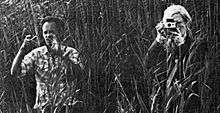
Films
Warhol appeared as himself in the film Cocaine Cowboys (1979).[152]
After his death, Warhol was portrayed by Crispin Glover in Oliver Stone's film The Doors (1991), by David Bowie in Julian Schnabel's film Basquiat (1996), and by Jared Harris in Mary Harron's film I Shot Andy Warhol (1996).
Warhol appears as a character in Michael Daugherty's opera Jackie O (1997). Actor Mark Bringleson makes a brief cameo as Warhol in Austin Powers: International Man of Mystery (1997).
Many films by avant-garde cineast Jonas Mekas have caught the moments of Warhol's life. Sean Gregory Sullivan depicted Warhol in the film 54 (1998). Guy Pearce portrayed Warhol in the film Factory Girl (2007) about Edie Sedgwick's life.[153] Actor Greg Travis portrays Warhol in a brief scene from the film Watchmen (2009).
In the movie Highway to Hell a group of Andy Warhols are part of the Good Intentions Paving Company where good-intentioned souls are ground into pavement.[154]
In the film Men in Black 3 (2012) Andy Warhol turns out to really be undercover MIB Agent W (played by Bill Hader). Warhol is throwing a party at The Factory in 1969, where he is looked up by MIB Agents K and J (J from the future). Agent W is desperate to end his undercover job ("I'm so out of ideas I'm painting soup cans and bananas, for Christ sakes!", "You gotta fake my death, okay? I can't listen to sitar music anymore." and "I can't tell the girls from the boys.").
Andy Warhol (portrayed by Tom Meeten) is one of main characters of the 2012 British television show Noel Fielding's Luxury Comedy. The character is portrayed as having robot-like mannerisms.
In the 2017 feature The Billionaire Boys Club Cary Elwes portrays Warhol in a film based on the true story about Ron Levin (portrayed by Kevin Spacey) a friend of Warhol's who was murdered in 1986.[155]
In September 2016, it was announced that Jared Leto would portray the title character in Warhol, an upcoming American biographical drama film produced by Michael De Luca and written by Terence Winter, based on the book Warhol: The Biography by Victor Bockris.[156]
Documentaries
- The documentary Absolut Warhola (2001) was produced by Polish director Stanislaw Mucha, featuring Warhol's parents' family and hometown in Slovakia.[157]
- Andy Warhol: A Documentary Film (2006) is a reverential, four-hour movie by Ric Burns[158] that won a Peabody Award in 2006.[159]
- Andy Warhol: Double Denied (2006) is a 52-minute movie by Ian Yentob about the difficulties authenticating Warhol's work.[160]
- Andy Warhol's People Factory (2008), a three-part television documentary directed by Catherine Shorr, features interviews with several of Warhol's associates.[161][162]
Television
- Warhol appeared as a recurring character in TV series Vinyl, played by John Cameron Mitchell.[163]
- In the episode of The Simpsons "Mom and Pop Art", Warhol appears in Homer's nightmare, throwing soup cans at Homer.
- Warhol was portrayed by Evan Peters in the American Horror Story: Cult episode "Valerie Solanas Died for Your Sins: Scumbag". The episode depicts the attempted assassination of Warhol by Valerie Solanas (Lena Dunham).
Honors
In 2002, the U.S. Postal Service issued an 18-cent stamp commemorating Warhol. Designed by Richard Sheaff of Scottsdale, Arizona, the stamp was unveiled at a ceremony at The Andy Warhol Museum and features Warhol's painting "Self-Portrait, 1964".[164][165] In March 2011, a chrome statue of Andy Warhol and his Polaroid camera was revealed at Union Square in New York City.[166]
See also
References
- ↑ Random House Webster's Unabridged Dictionary: "Warhol"
- ↑ "Andy Warhol painting sells for $105M". New York Daily News. November 13, 2013. Retrieved November 13, 2013.
- ↑ "A special report on the art market: The Pop master's highs and lows". The Economist. November 26, 2009. Retrieved August 14, 2010.
- ↑ "Andy Warhol: Biography". Andy Warhol Foundation for the Visual Arts. 2002.
- ↑ "Elder brother of Andy Warhol, who raised young artist, dies aged 85", Daily Mail, December 29, 2010.
- ↑ "Biography". Warhola.com. Retrieved August 14, 2010.
- ↑ V. Bockris, Warhol: The Biography, Da Capo Press, 2009, p. 15.
- ↑ "Mother". Warhola.com. Retrieved August 14, 2010.
- ↑ Paul Robert Magocsi, Ivan Pop, Encyclopedia of Rusyn History and Culture, University of Toronto Press, 2002.
- ↑ Jane Daggett Dillenberger, Religious Art of Andy Warhol, Continuum International Publishing Group, 2002, p. 7.
- ↑ Bockris, Victor (1989). The life and death of Andy Warhol. New York City: Bantam Books. pp. 4–5. ISBN 0-553-05708-1. OCLC 19631216.
- 1 2 "biography". warhol. Archived from the original on January 6, 2013. Retrieved January 13, 2013.
- ↑ "The Prince of Pop Art". Arthistoryarchive.com. Archived from the original on July 7, 2010. Retrieved August 14, 2010.
- ↑ "America's Most Creative Teens Names as National 2016 Scholastic Art & Writing Award Recipients" (Press release). Scholastic Inc. March 14, 2016.
- ↑ "Andy Warhol: The College Years". The Andy Warhol Museum. Retrieved February 9, 2015.
- ↑ "Sprite Heads Playing Violins, 1948". the warhol:. Archived from the original on February 9, 2015.
- 1 2 Gopnik, Blake. "Feb 9, 2015: The Daily Pic". Blake Gopnik on Art. Retrieved February 9, 2015.
- ↑ Colacello, Bob (1990), p. 19.
- 1 2 3 Benstock, Shari and Suzanne Ferriss (editors). Footnotes: On Shoes; Rutgers University Press; February 1, 2001; ISBN 978-0813528717; pp. 44–48.
- ↑ For Israel Miller see i.a. "A Little Jewel Box of a Shoe Store" by Christopher Gray, The New York Times, February 10, 2008.
- ↑ "Max Arthur Cohn" at SAAM.
- ↑ "Warhol's dollar bills painting fetches millions". MSNBC Today. November 12, 2009.
- ↑ Tony Scherman, David Dalton (2010). Pop: The Genius of Andy Warhol. HarperCollins. ISBN 9780060936631.
- ↑ Warhol, Andy; Glozer, Laslo, 1936-; Schellmann, Jörg; Edition Schellmann (1994), Andy Warhol, art from art, Edition Schellmann ; München : Schirmer/Mosel, ISBN 978-3-88814-725-8
- 1 2 3 Koestenbaun, Wayne (2015), Andy Warhol : a biography, New York, NY Open Road Integrated Media, Inc, ISBN 978-1-4976-9989-2
- ↑ Edward Wallowitch Young Man Smoking a Cigarette (c.1956 Gelatin silver print). The Andy Warhol Museum, Pittsburgh
- ↑ Three one-dollar bills mounted on cardboard (1962). Photograph by Edward Wallowitch. The Andy Warhol Museum, Pittsburgh; Founding Collection, Contribution The Andy Warhol Foundation for the Visual Arts, Inc.
- ↑ Printz, N. (2014). Making Money/Printing Painting: Warhol's Dollar Bill Paintings. Criticism, 56(3), 535-557.
- ↑ Oldham, Andrew; Simon Spence; Christine Ohlman (2002). 2Stoned. London: Secker and Warburg. p. 137. ISBN 0-436-28015-9. OCLC 50215773.
- ↑ Warhol biography, Gagosian Gallery. Retrieved March 24, 2011.
- ↑ Bodley Gallery Warhol exhibition announcement. Retrieved March 24, 2011.
- ↑ Angell, Callie (2006). Andy Warhol screen tests: the films of Andy Warhol: catalogue raisonné. New York City: Harry N. Abrams, Inc. p. 38. ISBN 0-8109-5539-3. OCLC 61162132.
- ↑ Livingstone, Marco (1992). Pop art: an international perspective. New York City: Rizzoli. p. 32. ISBN 0-8478-1475-0. OCLC 25649248.
- ↑ Lippard, Lucy R. (1970). Pop art. London: Thames & Hudson. p. 158. ISBN 0-500-20052-1. OCLC 220727847.
- ↑ "John Giorno". www.warholstars.org.
- ↑ Warhol, Andy (1975). The philosophy of Andy Warhol: from A to B and back again. San Diego: Harcourt Brace Jovanovich. pp. 100–101. ISBN 0-15-189050-1. OCLC 1121125.
- ↑ Colacello, Bob (1990), p. 67.
- ↑ Menand, Louis (January 11, 2010). "Top of the Pops". New Yorker.
- ↑ Grow, Krystal (September 23, 2014). "Time Lightbox". Time Inc.
- ↑ James, Dagon (2014). Billy Name:The Silver Age Black and White Photographs of Andy Warhol's Factory. Reel Art Press. p. 127. ISBN 1909526177.
- ↑ Schaffner, Ingrid (1999). The Essential Andy Warhol. New York City: Harry N. Abrams. p. 79. ISBN 0-8109-5806-6.
- ↑ Solanas, Valerie (2004) [1967]. SCUM Manifesto. London: Verso. ISBN 1-85984-553-3. OCLC 53932627.
- ↑ Jobey, Liz, "Solanas and Son," The Guardian (Manchester, England), August 24, 1996, p, T10 and following.
- ↑ Harding, James (2001). "The Simplest Surrealist Act: Valerie Solanas and the (Re)Assertion of Avantgarde Priorities". TDR/The Drama Review. 45 (4, Winter 2001): 142–162. doi:10.1162/105420401772990388.
- 1 2 Warhol, Andy; Pat Hacket (1980). POPism: the Warhol '60s. New York: Harcourt Brace Jovanovich. pp. 287–295. ISBN 0-15-173095-4. OCLC 5673923.
- ↑ Kristine Stiles; Peter Howard Selz (1996). Theories and Documents of Contemporary Art: a Sourcebook of Artists' Writings. University of California Press. pp. 345–. ISBN 978-0-520-20251-1. Retrieved January 13, 2013.
- ↑ "Warhol's Jackson goes on display". BBC News. August 7, 2009. Retrieved March 30, 2010.
- ↑ "Andy Warhol Expert art authentication, certificates of authenticity and expert appraisers". www.artexpertswebsite.com. Retrieved February 26, 2018.
- ↑ Delves Broughton, Philip (2012). The Art of the Sale. New York, NY: The Penguin Press. p. 165.
- ↑ "Andy Warhol Biography: From The Velvet Underground To Basquiat". Archived from the original on January 7, 2009. Retrieved January 6, 2009.
- ↑ Hughes, Robert (February 18, 1982). "The Rise of Andy Warhol". The New York Review of Books.
- 1 2 New York Media, LLC (January 27, 1992). New York Magazine Jan 27, 1992. Retrieved December 4, 2013.
- ↑ New York Media, LLC (April 8, 1996). New York Magazine Apr 8, 1996. Retrieved December 4, 2013.
- ↑ ""Speed Skater" official 1984 Sarajevo Winter Olympics poster by Andy Warhol".
- ↑ Piskor, Ed (2013). Hip Hop Family Tree. Fantagraphics. ISBN 1606996908.
- 1 2 3 Lando, Michal (April 8, 2008). "Reexamining Warhol's Jews". The Jerusalem Post. Archived from the original on July 3, 2011. Retrieved January 5, 2009.
- ↑ Bockris, Victor; Gerard Malanga (2002). Up-tight: the Velvet Underground story. London: Omnibus Press. p. 66. ISBN 0-7119-9170-7. OCLC 49906101.
- ↑ Vox, Tristan. "Purple Fame: An Appreciation of Prince at the Height of His Powers. Vanity Fair 1984 article, with especially commissioned portrait commissioned from Andy Warhol". Vanity Fair. Retrieved March 12, 2018.
- ↑ "Art historian, Thomas E Crow, analysis of Warhol's portrait of Prince, May 2018" (PDF). www.pacermonitor.com. Retrieved 2018-06-09.
- ↑ "Andy Warhol's Orange Marilyn 1962. Essay on the Warhol portrait style across three decades". www.christies.com. Retrieved March 11, 2018.
- ↑ "Prince (1984) : Andy Warhol : Artimage". www.artimage.org.uk. Retrieved March 11, 2018.
- ↑ "Andy Warhol and His Process: Screenprinting: sothebys.com". Archived from the original on 2016-04-13.
- ↑ Warhol, Andy; Hackett, Pat (2014). The Andy Warhol diaries (1st Twelve ed.). New York, NY: Twelve. ISBN 9781455561452. OCLC 881024850.
- ↑ Smith, Patrick S (1986). Andy Warhol's Art and Films; UMI Research Press; p.98; ISBN 0-8357-1733-X
- ↑ "The Soup Cans—Andy Warhol". Warholstars.org. Archived from the original on August 1, 2010. Retrieved August 14, 2010.
- ↑ "Early Lucian Freud Painting Leads Sotheby’s $100 Million Contemporary Art Evening Sale" by Colin Gleadell, Artnet, February 10, 2016
- ↑ Colacello, Bob (1990), p. 28.
- ↑ Bmw Art Car 1979: M1 by Andy Warhol, Car Body Design, March 27, 2006 (archived)
- ↑ "Bmw Art Car 1979: M1 by Andy Warhol". carbodydesign.com. Archived from the original on February 13, 2010.
- 1 2 Sotheby's – November 14, 2013 (November 14, 2013). "Record Warhol Leads Contemporary Sale | Sotheby's". Sothebys.com. Retrieved December 4, 2013.
- ↑ "Andy Warhol Biography (1928–1987)". Art Experts. Retrieved January 15, 2014.
- ↑ Colacello, Bob (1990). Holy terror: Andy Warhol close up. London: HarperCollins. p. 343. ISBN 0-06-016419-0. OCLC 21196706.
- ↑ Chiappini, Rudi (ed.), Jean-Michel Basquiat. Museo d'Arte Moderna /Skira, 2005.
- ↑ Fairbrother, Trevor. "Double Feature—Collaborative Paintings, Andy Warhol, Jean-Michel Basquiat," Art in America, September 1969.
- ↑ Fretz, Eric, Jean-Michel Basquiat: A Biography. Greenwood Press, 2010. ISBN 978-0-313-38056-3.
- ↑ Claudia Schmuckli, "Andy Warhol: The Last Supper" (June 1999 – December 2001) Guggenheim Museum SoHo. Retrieved September 21, 2014.
- ↑ Collaboration with Andy Warhol: Jean Michel Basquiat Archived March 4, 2016, at the Wayback Machine., The Andy Warhol Museum. Retrieved September 21, 2014.
- ↑ Court dispute over Alexander Iolas' estate: "Anagnostou vs. Stifel Case – Supreme Court of the State of New York", Leagle, Inc., December 6, 1990. Retrieved September 21, 2014.
- 1 2 Dillenberger, Jane (2001). The Religious Art of Andy Warhol. London: Continuum. pp. 10–11. ISBN 0-8264-1334-X. OCLC 59540326.
- ↑ Anthony Haden-Guest, "Warhol's Last Supper", ArtNet, 1999.
- ↑ Spector, Nancy. Maurizio Cattelan: All. New York, NY: Guggenheim Museum Publications, 2011
- ↑ Kennedy, Maev (September 1, 2001). "Warhol: Cars". The Guardian. London. Retrieved April 24, 2010.
- ↑ "Andy Warhol self-portrait fetches $38.4m". BBC News. May 12, 2011. Retrieved January 30, 2017.
- ↑ AP. "Warhol 'Elvis' sells for $37M; Lichtenstein, Weiwei works break own records at NYC auction". Washington Post. Retrieved May 10, 2012.
- ↑ "Warhol painting fetches record $105M at NYC auction". Fox News. November 13, 2013. Retrieved December 4, 2013.
- ↑ "Andy Warhol's Elvis triptych sells for $81.9m". BBC News. Retrieved November 13, 2014.
- ↑ "Andy Warhol Filmography". The Internet Movie Database. Retrieved September 29, 2009.
- ↑ Schaffner (1999), p. 73.
- ↑ Husslein, Uwe (1990). Pop goes art: Andy Warhol & Velvet Underground. Wuppertal. OCLC 165575494.
- ↑ Hudson, David (August 7, 2014). "This Is Softcore: The Art Cinema Erotica of Radley Metzger". Fandor. Retrieved February 29, 2016.
- ↑ Sandmir, Richard (April 4, 2017). "Radley Metzger, Whose Artful Erotica Turned Explicit, Dies at 88". The New York Times. Retrieved April 5, 2017.
- ↑ Metzger, Juliette; Feldman, Caryl; West, Ashley (April 2, 2017). "Press Release: Radley Metzger, pioneering filmmaker, dies at 88". The Rialto Report. Retrieved April 2, 2017.
- ↑ Staff (August 8, 2014). "The Lickerish Quartet". Film Society of Lincoln Center. Retrieved May 24, 2015.
- ↑ Canby, Vincent (July 22, 1969). "Movie Review – Blue Movie (1968) Screen: Andy Warhol's 'Blue Movie'". The New York Times. Retrieved December 29, 2015.
- ↑ Canby, Vincent (August 10, 1969). "Warhol's Red Hot and 'Blue' Movie. D1. Print. (behind paywall)". The New York Times. Retrieved December 29, 2015.
- ↑ Comenas, Gary (2005). "Blue Movie (1968)". WarholStars.org. Retrieved December 29, 2015.
- ↑ Staff. "Blue Movie (1969)". IMDB. Retrieved December 29, 2015.
- ↑ Staff (October 2005). "Blue Movie + Viva At NY Film Festival". WarholStars.org. Archived from the original on October 27, 2015. Retrieved January 20, 2016.
- ↑ Bego, Mark (2001). Aretha Franklin: The Queen of Soul. Da Capo Press. p. 250. ISBN 0-306-80935-4. OCLC 46488152. Retrieved March 29, 2009.
- ↑ "Can the Real David Bowie Rise, Please?". HUMO magazine. December 5, 1995. Archived from the original on June 16, 2013. Retrieved June 6, 2013.
- ↑ Russell, John (December 6, 1987). "Art". The New York Times. Retrieved January 5, 2009.
- ↑ May 3, 2006, auction at Doyle New York. Retrieved August 14, 2006.
- 1 2 Smith, John W., Pamela Allara, and Andy Warhol. Possession Obsession: Andy Warhol and Collecting. Pittsburgh, PA: Andy Warhol Museum, 2002, p. 46. ISBN 0-9715688-0-4.
- ↑ Colacello, Bob (1990), p. 183.
- ↑ Colacello, Bob (1990), pp. 22–23.
- ↑ Bourdon, David (1989). Warhol. New York: Harry N. Abrams. p. 51. ISBN 0-8109-1761-0. OCLC 19389231.
- ↑ "'Andy Warhol sketch found' in US garage sale". BBC News. April 2, 2012. Retrieved April 3, 2012.
- ↑ Staff of The Andy Warhol Museum (2004). Andy Warhol: 365 Takes. New York: Harry N. Abrams. p. 35. ISBN 0-500-23814-6. OCLC 56117613.
- ↑ Bourdon, David (1989). Warhol. New York: Harry N. Abrams. p. 231. ISBN 0-8109-1761-0. OCLC 19389231.
- ↑ Staff of The Andy Warhol Museum (2004). Andy Warhol: 365 Takes. New York: Harry N. Abrams. p. 157. ISBN 0-500-23814-6. OCLC 56117613.
- ↑ Ferguson, Michael (2005). "Underground Sundae". Archived from the original on January 16, 2009. Retrieved January 6, 2009.
- ↑ "Monsters and Critics – Andy Warhol Biography". Archived from the original on December 16, 2013. Retrieved July 28, 2013.
- ↑ George Walden, Who's a Dandy?—Dandyism and Beau Brummell, London: Gibson Square, 2002. ISBN 1-903933-18-8. Reviewed by Frances Wilson in "Uncommon People", The Guardian, October 12, 2006.
- ↑ Bourdon, David (1989). Warhol. New York: Harry N. Abrams. pp. 221–225. ISBN 0-8109-1761-0. OCLC 19389231.
- ↑ "The Andy Warhol Museum". Retrieved January 19, 2016.
- ↑ "Andy Warhol's Amiga Experiments". 2014. Retrieved May 19, 2014.
- ↑ Matheson, Whitney (August 6, 2013). "See six of Warhol's best film/TV appearances". USA Today. Retrieved March 17, 2018.
- ↑ Munroe, Don; Fremont, Vincent; Etkin, Sue (October 10, 1981). Andy Warhol's TV: Makeup and Death. NBC. Retrieved March 17, 2018.
- ↑ Obituaries (February 7, 2002). "Ernest Pintoff, 70; Animator Won Oscar". Los Angeles Times. Retrieved March 17, 2018.
- ↑ Warhol, Andy (1975). The philosophy of Andy Warhol : (From A to B and Back Again). New York: Harcourt Brace Jovanovich. ISBN 0-151-89050-1. OCLC 903973784. Retrieved March 17, 2018.
- ↑ See biographers such as Victor Bockris and art historian Meyer, Richard (2002). Outlaw Representation: Censorship and Homosexuality in 20th-Century American Art. Oxford University Press. p. 125. ISBN 0-19-510760-8.
- ↑ Matarazzo, Father Sam (1998). The Religious Art of Andy Warhol. New York: The Continuum Publishing Company. p. 33. ISBN 0-8264-1112-6.
- 1 2 3 Dillinger, Jane Daggett (2001). The Religious Art of Andy Warhol. New York: Continuum International Publishing Group. pp. 16–17. ISBN 978-0-8264-1334-5. Retrieved April 7, 2010.
- ↑ Scherman, Tony, & David Dalton, POP: The Genius of Andy Warhol, New York: HarperCollins, 2010, p. 49.
- ↑ Keller, Jerome (2007). "Warhol Superstars". Roundtable interview filmed at the Lauseanne Underground Film & Music Festival.
- ↑ "Billy Name | The man who silvered The Factory". CIVILIAN. Retrieved January 19, 2016.
- ↑ "Factory Workers Warholites Remember: Billy Name". Interview Magazine. Retrieved January 19, 2016.
- ↑ Boon, Marcus (Fall 2008). "John Giorno". Bomb (105). Retrieved September 18, 2016.
- ↑ O'Hagan, Sean (September 27, 2015). "I shot Andy Warhol: photographer Billy Name on drugs and shootings at the Factory". The Guardian. ISSN 0261-3077. Retrieved January 19, 2016.
- ↑ Koestenbaum, Wayne (2015). Andy Warhol: A Biography. Open Road Media. pp. 174–75.
- ↑ Bockris, Victor, Warhol: The Biography, Da Capo Press, 2003, Introduction, p. 2.
- ↑ Thomas Waugh, Hard to Imagine: Gay Male eroticism in Photography and Film from the Beginnings to Stonewall, New York: Columbia University Press, 1996.
- ↑ Butt, Gavin (2005). Between you and me: queer disclosures in the New York art world, 1948–1963. Durham, N.C: Duke University Press. p. 113. ISBN 0-8223-3486-0. OCLC 57285910.
- ↑ Fairbrother, Trevor (1989). "Tomorrow's Man". In Donna De Salvo. Success Is a Job in New York: the Early Art and Business of Andy Warhol. New York: Grey Art Gallery and Study Center. pp. 55–74. ISBN 0-934349-05-3. OCLC 19826995.
- ↑ Schmuckli, Claudia (1999). "Andy Warhol: The Last Supper". SoHo: Solomon R. Guggenheim Foundation. Archived from the original on January 16, 2009. Retrieved January 5, 2009.
- 1 2 3 4 5 Romaine, James (November 12, 2003). "Transubstantiating the Culture: Andy Warhol's Secret". Godspy. Retrieved January 5, 2009.
- ↑ MUCHNIC, SUZANNE (May 8, 1988). "Warhol: Pop Artist or Crusader for Tradition?". Los Angeles Times. ISSN 0458-3035. Retrieved February 26, 2018.
- ↑ "American Acquisition". Barber Institute of Fine Arts. Archived from the original on February 17, 2015. Retrieved February 16, 2015.
- ↑ "The 5 most unusual habits of Andy Warhol". Inktank.fi. November 20, 2012. Retrieved January 13, 2013.
- ↑ Boorstin, Robert O. (April 13, 1987). "Hospital Asserts it Gave Warhol Adequate Care". The New York Times. Retrieved January 2, 2009.
- ↑ Sullivan, Ronald (December 5, 1991). "Care faulted in the death of warhol". The New York Times. Retrieved August 14, 2010.
- ↑ "Andy Warhol Heirs Settle Lawsuit With Hospital Over Artist's Death". Orlando Sentinel. December 24, 1991. Retrieved December 4, 2013.
- 1 2 Gobnik, Blake. "Warhol's Death: Not So Simple, After All". The New York Times. Archived from the original on February 22, 2017. Retrieved February 22, 2017.
- ↑ Wilson, Scott. Resting Places: The Burial Sites of More Than 14,000 Famous Persons, 3d ed.: 2 (Kindle Location 49627). McFarland & Company, Inc., Publishers. Kindle Edition.
- ↑ "Introduction". The Andy Warhol Foundation for the Visual Arts. Retrieved January 2, 2009.
- ↑ "Artists Most Frequently Requested". Artists Rights Society. Archived from the original on January 31, 2009. Retrieved January 6, 2009.
- ↑ "Museum info: FAQ". The Andy Warhol Museum. Archived from the original on December 20, 2008. Retrieved January 6, 2009.
- ↑ "Frequently Asked Questions". The Andy Warhol Foundation for the Visual Arts. 2002. Archived from the original on January 6, 2009. Retrieved January 6, 2009.
- ↑ the Andy Warhol Foundation for the Visual Arts. (2007). The Andy Warhol Foundation for the Visual Arts 1987–2007 (PDF). New York City: The Andy Warhol Foundation for the Visual Arts. ISBN 0-9765263-1-X. OCLC 180133918. Archived from the original (PDF) on December 19, 2008. Retrieved January 6, 2009.
- ↑ Wachs, Joel; Michael Straus (2002). "Past & Present". The Andy Warhol Foundation for the Visual Arts. Archived from the original on January 6, 2009. Retrieved January 6, 2009.
- ↑ The Andy Warhol Museum, The Andy Warhol Foundation for the Visual Arts
- ↑ Lommel, Ulli (1979). Cocaine Cowboys.
- ↑ Hickenlooper, George. Factory Girl.
- ↑ Muir, John Kenneth (2011), Horror Films of the 1990s, McFarland, p. 236, ISBN 9780786440122
- ↑ The Andy Warhol Diaries (1989, ISBN 0-446-39138-7), edited by Pat Hackett; Entry date: Thursday, September 25, 1986; pp. 773.
- ↑ "Jared Leto to play Andy Warhol in biopic". The Guardian. Retrieved September 20, 2016.
- ↑ "TLA Releasing Unveils the past of Famed Artist Andy Warhol to Reveal a Story Few Ever Imagined in: Absolut Warhola" (PDF) (Press release). TLA Releasing. March 9, 2004. Archived (PDF) from the original on February 7, 2009. Retrieved January 9, 2009.
- ↑ Holden, Stephen (September 1, 2006). "A Portrait of the Artist as a Visionary, a Voyeur and a Brand-Name Star". The New York Times. Retrieved January 9, 2009.
- ↑ 66th Annual Peabody Awards, May 2007.
- ↑ "My Andy Warhol—Videos". Retrieved December 4, 2013.
- ↑ Welcome to the Silver Factory on IMDb
- ↑ "Andy Warhol's "Factory People"—PlanetGroupEntertainment". Planetgroupentertainment.squarespace.com. Retrieved December 4, 2013.
- ↑ "Martin Scorsese's Vinyl Is the Year's First Must-See Show".
- ↑ "Artists". United States Postal Service. Retrieved December 15, 2013.
- ↑ McCoy, Adrian (August 10, 2002). "Andy Warhol Puts Stamp on the World – Again". Pittsburgh Post-Gazette.
- ↑ "Andy Warhol Commemorated in Chrome on Union Square". the New York Times. March 31, 2011.
Further reading
- "A symposium on Pop Art". Arts Magazine, April 1963, pp. 36–45. The symposium was held in 1962, at The Museum of Modern Art, and published in this issue the following year.
- Bockris, Victor (1997). Warhol: The Biography. New York: Da Capo Press. ISBN 0-306-81272-X.
- Celant, Germano. Andy Warhol: A Factory. Kunstmuseum Wolfsbug, 1999. ISBN 3-7757-0773-5
- Colacello, Bob (1990). Holy Terror: Andy Warhol Close Up. New York: HarperCollins. ISBN 0-06-016419-0.
- Danto, Arthur C. (2009). Andy Warhol. Yale University Press. ISBN 978-0-300-13555-8.
- Dillenberger, Jane D. (2001). The Religious Art of Andy Warhol. New York: Continuum International Publishing Group. ISBN 0-8264-1334-X.
- Doyle, Jennifer, Jonathan Flatley, and José Esteban Muñoz, eds (1996). Pop Out: Queer Warhol. Durham: Duke University Press.
- Foster, Hal (1996). The Return of the Real. An October Book, MIT Press.
- Garrels, Gary (1989). The Work of Andy Warhol: Discussions in Contemporary Culture, no. 3. Beacon NY: Dia Art Foundation.
- Guiles, Fred Lawrence (1989). Loner at the Ball: The Life of Andy Warhol. New York: Bantam. ISBN 0-593-01540-1.
- James, James, "Andy Warhol: The Producer as Author", in Allegories of Cinema: American Film in the 1960s (1989), pp. 58–84. Princeton: Princeton University Press.
- Koestenbaum, Wayne (2003). Andy Warhol. New York: Penguin. ISBN 0-670-03000-7.
- Krauss, Rosalind E. "Warhol's Abstract Spectacle". In Abstraction, Gesture, Ecriture: Paintings from the Daros Collection. New York: Scalo, 1999, pp. 123–33.
- Lippard, Lucy R., Pop Art, Thames and Hudson, 1970 (1985 reprint), ISBN 0-500-20052-1
- Livingstone, Marco; Dan Cameron; Royal Academy (1992). Pop art: an international perspective. New York: Rizzoli. ISBN 0-8478-1475-0.
- Michelson, Annette (2001). Andy Warhol (October Files). Cambridge MA: The MIT Press.
- Scherman, Tony, & David Dalton, POP: The Genius of Andy Warhol, New York, NY: HarperCollins, 2009
- Suarez, Juan Antonio (1996). Bike Boys, Drag Queens, & Superstars: Avant-Garde, Mass Culture, and Gay Identities in the 1960s Underground Cinema. Indianapolis: Indiana University Press.
- Watson, Steven (2003). Factory Made: Warhol and the 1960s. New York: Pantheon. ISBN 0-679-42372-9. Archived from the original on August 29, 2010.
- Warhol, Andy (1975). The Philosophy of Andy Warhol: (From A to B and Back Again). Hardcore Brace Jovanovich. ISBN 0-15-189050-1.
- Warhol, Andy; Pat Hackett (1980). POPism: The Warhol Sixties. Hardcore Brace Jovanovich. ISBN 0-15-173095-4.
- Warhol, Andy; Pat Hackett (1989). The Andy Warhol Diaries. Warner Books.
- Yau, John (1993). In the Realm of Appearances: The Art of Andy Warhol. Hopewell, NJ: Ecco Press. ISBN 0-88001-298-6.
External links
| Wikiquote has quotations related to: Andy Warhol |
| Wikimedia Commons has media related to Andy Warhol. |
- Andy Warhol at Encyclopædia Britannica
- Andy Warhol at the National Gallery of Art
- Warhol Foundation in New York City
- Andy Warhol Collection in Pittsburgh
- The work of Andy Warhol spoken about by David Cronenberg
- Warholstars: Andy Warhol Films, Art and Superstars
- Warhol & The Computer
- Andy Warhol
- Andy Warhol at the Jewish Museum